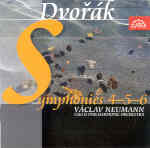This central panel in Václav Neumann’s excellent Dvorák symphony cycle starts out with the inestimable advantage of the Czech Philharmonic in top form, but it won’t do to diminish the quality of artistic insight coming from the podium. Take the Fourth Symphony, for example: Listen to how Neumann has the winds in the scherzo emphasizing their dotted rhythms against the triple-time accompaniment, and the increased musical tension this generates. Smart man! The finale takes one of Dvorák’s most interesting formal experiments (it’s the earliest extant prototype for the Romantic finales of Tchaikovsky’s First Piano Concerto and Rachmaninov’s Second and Third Piano Concertos and Second Symphony) and weds it to arguably the least interesting principal tune that he ever wrote. The movement has never sounded better than it does here. Neumann understands the need to soft-pedal the “one-two-three” motive and stress lyrical elements wherever possible, and the result makes a musical silk purse out of a real potential sow’s ear.
Both the Fifth and Sixth Symphonies are of course masterpieces all the way through, and from the first sound of those inimitably Czech clarinets that open the Fifth, you know it’s going to be smooth sailing. A beautifully flowing slow movement, breezy scherzo, and brilliant finale with a hugely exciting coda characterize an exceptional performance. The same virtues hold true in the Sixth, where Neumann doesn’t put a foot wrong. Of course there will be other performances of this glowing work with something special to offer: Ancerl’s for example, with this same orchestra, and no one touches Kubelik in the scherzo. But Neumann more than holds his own in this august company, and as regards interpretation, execution, and sound taken in tandem, there is no finer Dvorák cycle than this one. [3/8/2003]
































